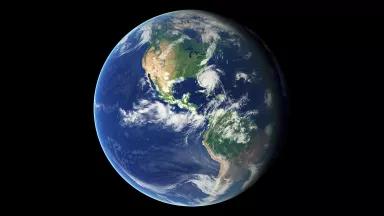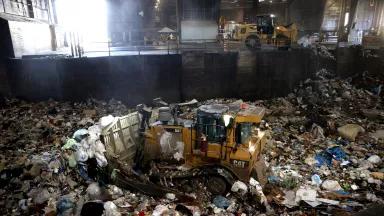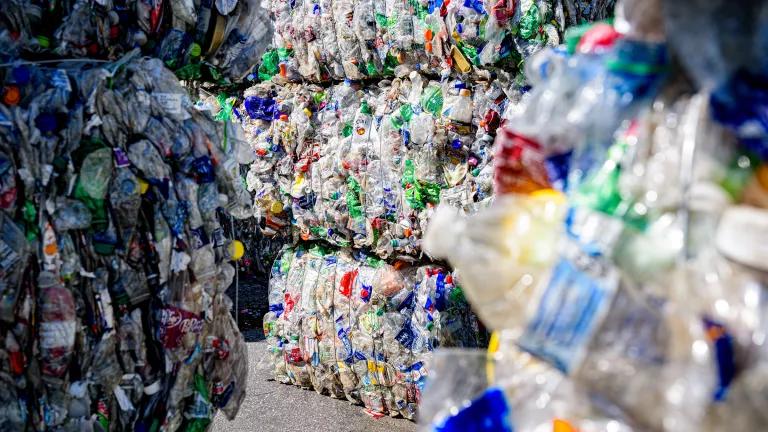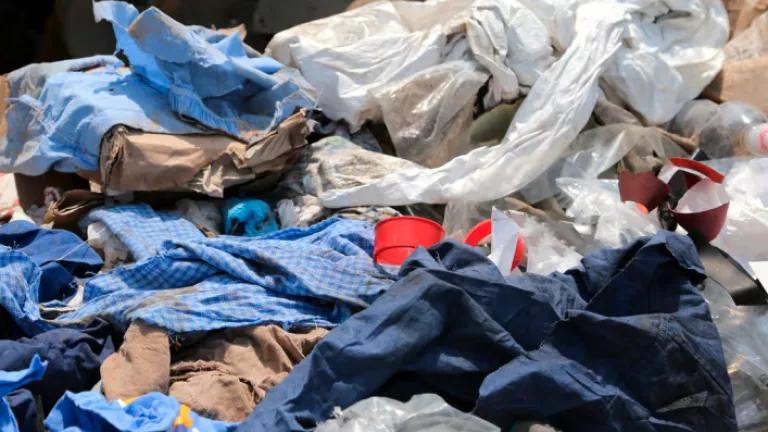What You Need to Know About the Plastic Crisis
Plastic pollution imperils our health and the well-being of the planet.

A recent investigation by Orb Media found microplastics in 94 percent of U.S. tap water samples.
Brian Maranan Pineda for NRDC (child); Adobe Firefly (microplastics illustration)
Global annual production of plastic has increased exponentially over the past 65 years, growing from two million metric tons in 1950 to 460 million metric tons in 2019. Much of this plastic quickly becomes waste, and plastic waste is found everywhere, including the farthest reaches of the Arctic, the deep seabed, and even in clouds and the atmosphere.
In a recent study, every human placenta tested was found to have microplastics in it. An estimated 242 million metric tons of plastic waste is generated globally every year, and the United States is one of the top generators. At least 1,565 wildlife species have been found to accidentally ingest plastic—which can lead to starvation, intestinal blockages, and death—and even more wildlife are injured or die every year due to plastic entanglement.
Yet plastic pollution is not just a waste issue to be managed and not just a problem for wildlife. It is a human and planetary health crisis that requires immediate and decisive action at all levels of government.
Significant impacts on water quality, human health, and climate and ecosystem stability
Plastics release harmful compounds into our air, food, water, and the environment during production, everyday use, and at the end of their life. The 16,000-plus chemicals used to make different kinds of plastic (such as phthalates, bisphenol A, and vinyl chloride) include carcinogens, hormone disruptors, obesity-causing compounds, and substances that can cause harm to the liver, brain, kidneys, and the cardiovascular, immune and reproductive systems; many others are unstudied.
During production, transportation, use, recycling, disposal, and when leaked into the environment, plastics shed and are fragmented into microplastics—tiny pieces of plastic that are less than five millimeters long. A recent investigation found microplastics in 94 percent of U.S. tapwater samples, which was the highest rate of contamination in the world, according to the research; bottled water contained even higher amounts.
Microplastics have been found to pose digestive, reproductive, and respiratory hazards in mice, and are suspected to cause similar hazards in humans. Microplastics have been found in the heart, lungs, organs, breast milk, placentas, stool, and blood of humans. A recent human study found a higher risk of heart attacks, stroke, and death among patients that had microplastics in a key heart artery.
In addition, 99 percent of all plastics are made from fossil fuels and are an increasingly important contributor to climate change. Plastics also contribute to toxic pollution throughout their life cycle, with frontline communities being particularly impacted by toxic air and water pollutants emitted by plastic production and disposal facilities.
Plastic pollution is largely irreversible. It is too widespread and diffuse to realistically clean up, and it is simply not possible to remove such contaminants from the blood and tissues of billions of organisms. Plastics are not only harming human and environmental health, but they may also be endangering the healthy functioning of the earth system as a whole. Simply put, we need to stop adding to an already massive problem.
We can’t recycle our way out of the plastics crisis
It is also important to recognize that we will not be able to recycle our way out of the plastics problem. Between 5 percent to 6 percent of postconsumer plastic was recycled in the United States in 2021. Most plastic isn’t designed to be recycled, and there are hundreds—if not thousands—of different kinds of plastics, most of which can’t be recycled together. Moreover, recycling doesn’t solve the fact that plastics are made from and contain toxic chemicals and nonrenewable source material, as well as shedding microplastics.
What the chemical and plastic industries misleadingly call “chemical recycling” or “advanced recycling” isn’t the answer either. These are greenwashing terms for a set of plastic waste disposal methods that generate hazardous waste, toxic air pollution, and cancer-causing fuels.
NRDC research has shown that the “chemical recycling” facilities currently in operation mostly are not producing or planning to produce new plastic but are engaging in a form of plastic incineration—turning plastic into dirty fuel using energy-intensive processes or using them to generate energy for their processes. This plastic-to-fuel process does not offer any of the ecological and economic benefits of true recycling, which returns materials to the production cycle. Other “chemical recycling” facilities that aren’t creating fuels out of discarded plastic are still generating hazardous waste, exacerbating environmental injustices, and recycling little, if any plastic.
The same industries that deceived the public on plastics recycling now claim they have a new answer and to trust them on this, but we have no reason to trust them—their goal isn’t to solve the problem, it’s profit.
The industries aim to avoid responsibility while producing even more unnecessary plastic and toxic pollution. These technologies are false solutions, which could pose even greater threats than they already do if the chemical industry is successful in their attempts to eliminate environmental protections at the state and federal levels, including the Clean Air Act, the Solid Waste Disposal Act, and the Toxic Substances Control Act.
Action needed now: Global Plastic Treaty negotiations approaching
The plastics crisis has become so acute that nations around the world agreed in 2022 to begin negotiations on a global plastics treaty to address plastic pollution. The fourth negotiating session is scheduled to take place in Ottawa, Canada, in late April 2024. How such an agreement will ultimately reduce the threats posed by plastic remains to be seen, but the treaty negotiation process is an unprecedented opportunity for action toward this goal. What is clear is that urgent action is needed at all levels to reduce both the production and use of plastics, especially unnecessary plastics and the most toxic plastics.
Policy recommendations
To protect the health of communities on the front lines of plastic production and disposal, as well as the general public, wildlife, and ecosystems, we need mandates on the international, federal, state, and local policy levels that stem the tide of plastic, by curbing production, particularly in the short term by eliminating the most toxic plastics and unnecessary plastics; guarding against false solutions like “chemical recycling”; and investing in real solutions that will protect both communities and the planet.
We must also reduce the harms caused by plastic that remain by reducing pollution from plastic production and disposal. Specifically, in the ongoing global plastic treaty negotiations, countries should adopt control measures which reduce plastic production; identify and then eliminate toxic chemicals in plastic production; prohibit the production and trade of problematic plastics; and require manufacturers to disclose the chemical content of plastics.
National, state, and local policymakers should:
- Ban the most toxic, unnecessary, and problematic forms of plastics, as detailed in NRDC’s fact sheet “The Worst of the Worst: High Priority Plastic Materials, Chemical Additives, and Products to Phase Out.” Reduce and minimize all forms and uses of fossil fuel–based plastic in favor of alternatives that are safe and sustainable by design. This can take the form of laws that ban single-use plastics, particularly toxic plastics, as well as banning intentionally added microplastics, among others.
- Require full transparency of chemicals in plastics throughout the process of production, use, and disposal.
- Mandate testing for microplastics in drinking water and seek solutions to prevent further microplastic contamination of our rivers, lakes, oceans, soils, bodies, and drinking water.
- Increase investment in the development of safer and more sustainable chemicals and materials, as well as solutions that reduce plastic production such as nontoxic reuse and refill systems.
- Adopt reduction targets for plastics at the state, federal, and local levels, similar to climate action plans that set goals for greenhouse gas reductions.
- Discontinue support—including via permitting, deregulation, and subsidy—for plastic waste treatment and disposal methods that generate hazardous waste and toxic air pollution, including processes which the plastic industry is greenwashing as “chemical recycling,” “advanced recycling,” and “molecular recycling.”
- Work together with environmental justice communities to ensure that any solutions help to alleviate the disproportionate impacts and health harms that low-income communities, communities of color, and other at-risk populations continue to experience. To help accomplish this, incorporate cumulative exposures into policy and permitting decisions.
Plastic pollution has been linked to everything from cancer in humans to death in wildlife.
A strong Global Plastics Treaty could help rid the world of harmful plastics—and as one of the world’s largest producers, the U.S. has a critical role to play.

Urge the Biden administration to enact a strong Global Plastics Treaty
Plastic pollution has been linked to everything from cancer in humans to death in wildlife. A strong Global Plastics Treaty could help rid the world of harmful plastics—and as one of the world’s largest producers and consumers of plastic, the United States has a critical role to play.








